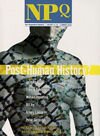I missed this one, but due to my budding, Scottish roots (do roots bud?), it seemed important to prevent it from slipping into the ether.....
New Media Scotland & Stills present an
International Symposium - Designer Bodies: Towards The Posthuman ConditionScottish National Gallery of Modern Art: Gymnasium
75 Belford Road, Edinburgh
Saturday, 3rd April 2004 10:30am– 6pm
£15 / £10 concessions (includes refreshments and buffet lunch)
Early booking essential due to limited seating. Please register using the form below.
Download the Registration Form
The symposium aims to unravel the aesthetics, ethics and future of biosciences. Do works of art inspired by new scientific insights into genetics explore the posthuman condition? Do biomedical science and genetics have a similar creative impact on contemporary art to that of anatomy during the Renaissance? What are the implications for artists using DNA and genetically modified organisms as their media of choice? How do we view today's alliances of science and art?
Speakers include:
- award-winning artists Christine Borland, Gina Czarnecki, Gair Dunlop
- Jens Hauser, Curator of L'Art Biotech, France - the first festival of biotechnological living art
- Steve Kurtz, Critical Art Ensemble, USA – an artists' collective dedicated to exploring the intersection between art, technology, politics and critical theory
- Dr. Keith Skene, a scientist working in Environmental and Applied Biology, University of Dundee
- Dr. Warren Neidich, USA - an artist-in-residence at Goldsmiths College, London and founder of the field of Neuroaesthetics
- Dr. Alan Bleakley, Psychologist and Senior Lecturer in Medical Education, Royal Cornwall Hospital, Truro & Peninsula Medical School, Exeter
- Hannah Redler, Energy Project Leader, Science Museum, London
- Bronac Ferran, Director of Interdisciplinary Arts, Arts Council England.
The related exhibition, Designer Bodies shows at Stills from 3rd April – 6th June 2004. Artists Christine Borland, Gina Czarnecki, Jacqueline Donachie and Gair Dunlop use photography, film and digital media to explore the implications of genetics for disease treatment, human bioderversity, social perceptions and species boundaries. The resulting works spark excitement, fear and awe.
Organised by New Media Scotland and Stills, Edinburgh. In association with the Scottish National Gallery of Modern Art; Edinburgh International Science Festival; London Science Museum and Arts Catalyst - the Science and Art Agency. Supported by the Wellcome Trust, Scottish Arts Council, Arts Council England and Edinburgh City Council.







